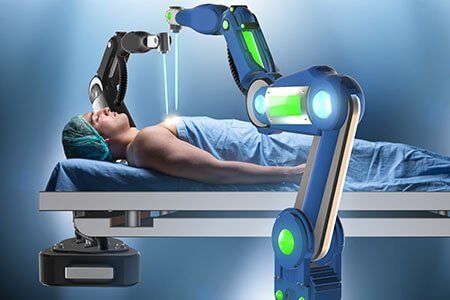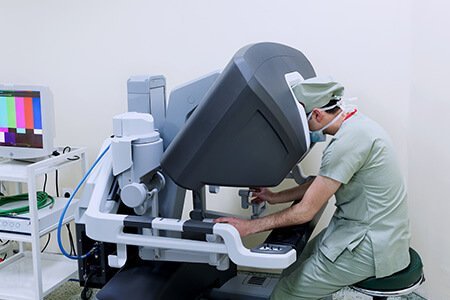Robotic kidney transplantation
Robot assisted kidney transplantation, its benefits, risks, success rates and costs
Things you need to know about Robotic kidney transplantation
What is robot assisted kidney transplantation?
Kidney Transplantation (KT) is the most preferred standard care of treatment for patients with end stage renal disease. Traditionally, kidney transplantation has been carried out by open surgery i.e by making large incisions. However, in the recent times, the procedure is being done with minimally invasive surgical procedures.
Robot Assisted Kidney Transplantation (RAKT) is a minimally invasive technique that uses a robotic support to perform the KT. As a high level of expertise is required in KT and robotic surgery, RAKT is performed by transplant surgeons with extensive training and experience in robotics and transplant surgery.
How does robot assisted kidney transplant surgery work?
The Technique:
Compared to conventional open kidney transplant surgery, a much smaller incision (about 7cm) is made in RAKT to remove the diseased kidney and insert the donor kidney into the abdomen., and then to stitch the blood vessels and the ureter. Another four or five small (0.5 to 1cm) incisions are used to insert the instruments into the abdomen.
One of the arms holds a high magnification 3D camera which is inserted into the abdomen through one of the key holes and provides a high-definition, magnified (12×), 3-D view of the surgical site. The other mechanical arms have surgical instruments attached to it that are designed to mimic the movement of the human hands and wrists.
The surgeon uses the console of the computer to manipulate the small surgical instruments that are more flexible and manoeuvrable as compared to the human hand.
What are the advantages of robotic kidney transplant surgery over open kidney transplant surgery?
The technical advantage of robotic kidney transplant surgery over open kidney transplant surgery
- The robot replicates the surgeon’s hand movements, while minimizing hand tremors. The surgeon thus can not only make use of his/her experience and skills, but also operate with precision, dexterity and control in complex procedures.
- Especially useful when the operative field is deep and narrow, and requires fine dissection and micro suturing.
Improved patient outcomes:
Robotic surgery in KT offers many benefits like:
- Decreased chances of complications as compared to open surgery, especially in immunocompromised and end-stage renal disease patients undergoing KT.
- Safer and more efficacious for obese patients who are otherwise not recommended for transplants.
- Minimal invasive surgery helps in reduced
- – blood loss
- – hospital stays
- – pain
- – postoperative complication rate
- – recovery time
- – surgical scars
What is robot assisted surgery?
Robotic surgery, or robot-assisted surgery, is an advanced surgical procedure where small surgical tools are attached to a robotic arm that is controlled by a surgeon through a computer.
What are the risks of kidney transplant using robot assisted surgery?
Risks related to kidney transplants are drastically minimized with the robotic assistance. Still, possible risks that are specific to kidney transplant procedure include:
- Damage to surrounding structures
- Development of a hernia due to the small incisions made for the instruments, known as ‘port site hernia’
- Twisting of the kidney (torsion) after the transplant
- Scarring affecting the bowel in the long term (adhesive obstruction)
- Trapping of carbon dioxide used during surgery in the abdomen
- Nerve compression
- Life threatening risks are miniscule.
What preparations are required before robotic kidney transplant surgery?
Before transplant instructions include:
- Stop smoking or drinking
- Lose any excess weight
- Regular exercise
- Vaccinations as advised
- Dialysis before transplant
- Necessary lab tests
What is the success rate of kidney transplant using robot assisted surgery?
The graft survival rate i.e the survival rate of the donor kidney is dependent on the inherent characteristics of the recipient’s body, hence there are no significant differences between the open surgery and robot assisted kidney transplant surgery. However, the robotic kidney transplant surgery offers significant benefits in terms of
- Low surgical site infection (range 0-8%)
- Incisional hernia rates (range 0-6%)
- Improved aesthetic outcomes
What factors should be considered while choosing a hospital for robotic kidney transplant?
Since kidney transplant is a major surgery, it is important to ensure that the hospital has the infrastructure and trained team to support the pre-operative and post-operative needs. Certain factors to be considered are:
- State-of-the-art robotic surgery, latest transplant technology and organ preservation facilities.
- Expertise of the kidney transplant surgeons and his team. Specialized training in robotics, number of surgeries performed and success rate indicate the expertise of your surgeon.
- Number and type of robotic kidney and other organ transplants that the center performs every year.
- Transplant center’s organ donor and recipient survival rates.
- Support services such as diagnostics, pharmacy, modular OT, ICU etc.

What factors govern the cost of robotic kidney transplant?
The cost of surgery usually depends on a multitude of factors, the primary ones being:
- Experience and expertise of the kidney transplant surgeon and team.
- Length of surgery and post surgical complications.
- Underlying co-morbidities and age of the patient which may affect the – additional tests and medicine requirement.
- Hospital stays – Room category availed; depending on the hospital’s billing policy.
To know more about robotic surgery and robotic kidney transplant, you can request for a call back and our robotic kidney transplant specialist will call you and answer all your queries.
References:
- Robot-assisted kidney transplantation – pilot study. Available at https://www.guysandstthomas.nhs.uk/resources/patient-information/kidney/robotic-assisted-kidney-transplantation.pdf. Accessed on March 28, 2018
- Breda A, Territo A, Gausa A, et al. Robot-assisted Kidney Transplantation: The European Experience. European urology. 2018; 73: 273– 281.
- Oberholzer J, Giulianotti P, Danielson KK, et al. Patients Previously Denied Access to Transplantation. Minimally Invasive Robotic Kidney Transplantation for Obese. Am J Transplant. 2013 March; 13(3): 721–728. doi:10.1111/ajt.12078.









